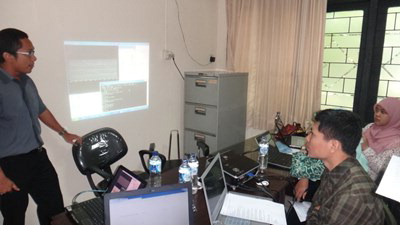Dr. Kuswanto and his group investigated data availability for several sites across Java Island, confirming their findings with BMKG. They decided to first develop composite maps for extreme high temperatures in Surabaya, identifying the thresholds in temperature and duration. A temperature exceeding 36.2 degrees Celsius for more than 3 days has a significant impact on society, and it is also a preliminary indication of a drought event. The researchers performed statistical tests on their sample and developed computer code to build the maps, analyzing their work as they went. Team members presented their results at a variety of events, including Global Engineer Asia 2015, Euro-Asia Civil Engineering Forum (EACEF) and a workshop of climate change and disaster organized by Research Center for Earth, Disaster and Climate Change at ITS. The researchers installed and are maintaining a rain gauge to generate a time series dataset to support future studies.
The PEER team also organized a “Young Forecaster” workshop, to increase students’ interest in working as weather forecasters and provide them with knowledge about extreme weather events. The team received more applications for the workshop than there were spots, so they opened it up to an additional 10 students. Workshop participants attended a class as well as laboratory sessions. Several participants joined the team’s Extreme Weather and Climate Research (Extreme WeCaRe) Group. This group, developed during the PEER project, is for young and early career researchers in Indonesia interested in multiple aspects of extreme weather and climate. Under this research group, two new related research projects have received grants, and the PI Dr. Kuswanto also went on to win a second PEER award in Cycle 5 (2016-2020). PEER project support was also key in helping several students involved in the research finish their theses for Master’s and Bachelor’s programs.
The team wrote and delivered a technical report to BMKG as their key project deliverable. It consists of a detailed procedure for developing composite maps. The researchers expect that BMKG forecasters will be easily able to replicate the procedure to develop similar maps for other regions in Indonesia, and they are also developing a mentoring program with BMKG researchers to support ongoing efforts on map development and validation.
PublicationsHeri Kuswanto, Shofi Andari, and Erma Oktania Permatasari. 2015. Identification of Extreme Events in Climate Data from Multiple Sites.
Procedia Engineering 125: 304-310.
https://doi.org/10.1016/j.proeng.2015.11.067 Heri Kuswanto, Shofi Andari, Erma Oktania Permatasari, Kiky Ferawati, Nike Nur Armanda, Epha Supriyanto, and Sri Hidayati. 2015. Laporan Teknis: Peta Komposit (Composite Maps) untuk prediksi hujan ekstrim di indramayu, Jawa Barat [Technical Report: Composite Maps for predicting extreme rain in Indramayu, West Java].
Back to PEER Cycle 2 Grant Recipients



